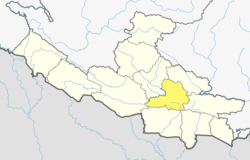Arghakhanchi District
Arghakhanchi (Nepali: अर्घाखाँची जिल्ला![]()
Arghākhānchī District अर्घाखाँची जिल्ला | |
|---|---|
District | |
 Location of Arghakhanchi (dark yellow) in Province 5 | |
| Country | |
| Province | Province No. 5 |
| Admin HQ. | Sandhikharka |
| Government | |
| • Type | Coordination committee |
| • Body | DCC, Arghākhānchī |
| Area | |
| • Total | 1,193 km2 (461 sq mi) |
| Area rank | 077 |
| Population (2011)[1] | |
| • Total | 197,632 |
| • Density | 170/km2 (430/sq mi) |
| Time zone | UTC+05:45 (NPT) |
| Main Language(s) | Nepali |
| Website | daoarghakhanchi |
History
The district consists of two pre-unification principalities Argha and Khanchi. Argha (Nepali:अर्घा) was the name given to ritual offerings made at the former principality's main Bhagwati Temple. Khanchi may come from the word Khajanchi (Nepali:खजाञ्चि) or tax collector since the center of the latter principality was known for its tax office. Both were two of the Chaubisi rajya (24 principalities) centred in the Gandaki Basin. In 1786 A.D. (1843 BS) during the unification of Nepal the two were annexed by Gorkha. Later the merger was renamed “Arghakhanchi” and added to Gulmi District. Arghakhanchi became a separate district in 1961 A.D. (2018 BS).[2]
Demographics
In 2001, the population was 208,391.[3] In 1991, the population was 180,884.[3]
At the time of the 2011 Nepal census, Arghakhanchi District had a population of 197,632. Of these, 97.4% spoke Nepali, 1.4% Magar and 0.5% Kumal as their first language.[4]
According to the 2011 census the total population was 197,632. Of these 86,266 were male and 111,366 are female. The total number of households was 46,835 and the average household size 4.22 on the basis of usual place of residence. The sex ratio (number of males per 100 females) was 77.5 and population density was 166. The major religion of this district is Hindu, followed by Islam.[1]
Geography and climate
Arghakhanchi lies between 27'45"N and 28'6"N latitude, and 80'45"E to 83'23"E longitude. It covers 1,193 km2. The altitude of the district varies from 305 to 2515 meter above the sea level. 68% of the district is in the mountainous Mahabharat Range and the rest is in the Siwalik Hills. Elevations range from 305–2575 m above sea level and about 40% of the total area is forested.[2]
The major rivers of the district are Bangi Khola, Bangsari Khola, Mathurabesi Khola, Banganga Khola, Durga Khola, Sita Khola, Khakabesi Khola, Rangsing Khola, Ratne Khola, Jhimruk Khola, and Khankbesi Khola. The major lakes of the district are Thada lake and Sengleng lake.
| Climate zone[5] | Elevation range | % of area |
|---|---|---|
| Lower Tropical | below 300 meters (1,000 ft) | 0.2% |
| Upper Tropical | 300 to 1,000 meters 1,000 to 3,300 ft. |
50.5% |
| Subtropical | 1,000 to 2,000 meters 3,300 to 6,600 ft. |
49.1% |
| Temperate | 2,000 to 3,000 meters 6,400 to 9,800 ft. |
0.2% |
Administration
The district consists of six municipalities, out of which three are urban munic=स्थानिय तह |url=https://web.archive.org/web/20180831065451/http://103.69.124.141/ |publisher=Ministry of Federal Affairs and General Administration |accessdate=1 October 2018 |language=Nepali}}</ref>
- Sandhikharka Municipality
- Sitganga Municipality
- Bhumikasthan Municipality
- Chhatradev Rural Municipality
- Panini Rural Municipality
- Malarani Rural Municipality
Towns and villages
The major town in the district is Sandhikharka which is the headquarter of Arghakhanchi district in the Lumbini Zone of Nepal. It is almost 300 km (190 mi) southwest of Nepal's capital of Kathmandu.
There are many small villages in the district, including Mareng, Bhagawati, Asurkot, Chhatradev Arghakhanchi, Chhatragunj Arghakhanchi Lamchi, Balkot, Bangi, Dharapani, Sandhikharka Dhikura, Dibharna, Khanchikot, Kimadada, Kura, Phudbang, Bangla, Adguri, Khana, Khanadaha, Pali, and Dhatiwang.
Hatari Neta is a government school in Arghakhanchi. They are said to have good facilities in terms of roads, electric power, education, etc. Villages in the west and south part of the district have relatively little development as compared to the villages of the north and east side. Sano Gaun is the most popular place for visit. Lamchi is another popular village in Arghakhanchi.
Deurali temple is in the area and so are Supa Deurali, Argha Mandir and other temples.
References
- "National Population and Housing Census 2011(National Report)" (PDF). Central Bureau of Statistics. Government of Nepal. November 3, 2012. Archived from the original (PDF) on May 25, 2013. Retrieved November 3, 2012.
- "Districts". 28 June 2012. Archived from the original on June 18, 2010. Retrieved 18 August 2012.
- "Nepal Districts". statoids.com. Retrieved 18 August 2012.
- 2011 Nepal Census, Social Characteristics Tables
- The Map of Potential Vegetation of Nepal - a forestry/agroecological/biodiversity classification system (PDF), . Forest & Landscape Development and Environment Series 2-2005 and CFC-TIS Document Series No.110., 2005, ISBN 87-7903-210-9, retrieved Nov 22, 2013
External links
| Wikimedia Commons has media related to Arghakhanchi District. |